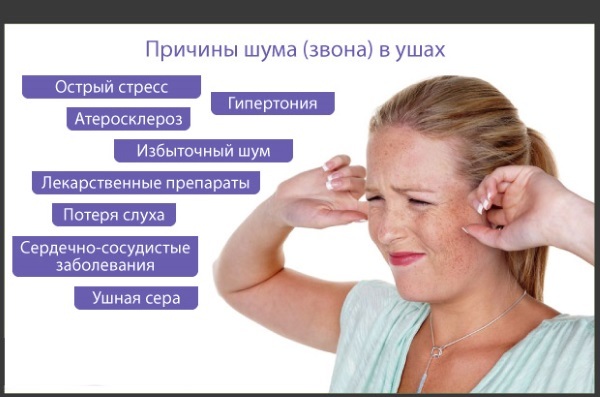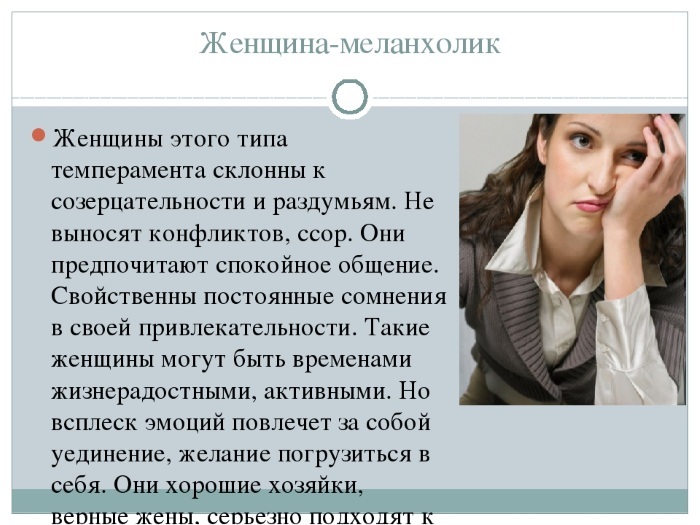Content
- Definition of disinfection
- Goals and objectives of the event
- Disinfection levels
- What and how is disinfected in a healthcare facility
- Surfaces
- Air
- Linens
- Medical devices and instruments
- Methods and types of disinfection in healthcare facilities, algorithm of carrying out
- Preventive
- Focal
- The final
- Disinfectants
- Disinfection and sterilization
- Disinfection and cleaning
- Disinfection solution
- Disinfection tablets
- Disinfection video
Disinfection in healthcare facilities - this is the complete destruction of pathogenic microorganisms at environmental facilities, carried out in medical institutions. There are several main types of disinfection, applied depending on the goals that need to be achieved.
Definition of disinfection
Disinfection in medical institutions is a procedure aimed at disinfecting rooms and surfaces and preventing the spread of various pathogens. Such events are mandatory for any type of premises, especially organizations and healthcare structures.
Goals and objectives of the event
The main tasks of disinfection is to prevent the spread of various infectious and viral diseases by destroying the places of accumulation of pathogenic microorganisms.
Also, the measures are designed to disinfect medical items and prevent infection of the medical staff.
Disinfection levels
There are 3 main levels of disinfection, which are applied depending on the premises and the tasks that you want to achieve.
Classification:
- High level. The procedure allows you to destroy pathogenic microorganisms on semi-critical medical objects - catheters, droppers, probes. Disinfection is effective against fungi, vegetative pathogens, tuberculosis bacteria, lipid and non-lipid microorganisms. Not used to remove spore pathogens from surfaces.
- Average. In addition to semi-critical objects, all non-critical objects with a hard, smooth surface are subject to decontamination. The procedure is effective against fungi, tuberculosis pathogens, vegetative microorganisms, the vast majority of viral pathogens. Does not affect spore pathogens.
-
Short. Disinfection is carried out on non-critical objects (baths, thermometers). The procedure is aimed at destroying some fungi, vegetative pathogens, viruses. Disinfection does not get rid of tuberculosis bacteria and spore microorganisms.
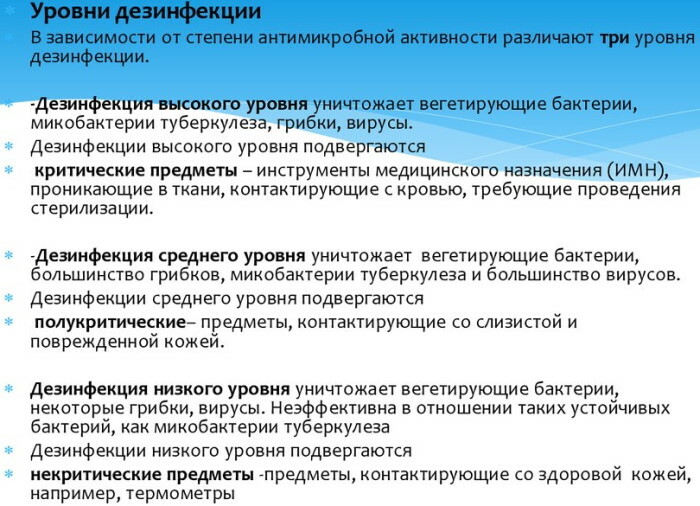
One or another level is applied in accordance with the regulations established by the Ministry of Health.
What and how is disinfected in a healthcare facility
Disinfection in health care facilities (the types of treatment used depend on the specific facility of the institution) are carried out with periodic and regularity, established by the rules of sanitary and epidemiological standards.
Various objects installed in the premises are subject to disinfection - bed linen, work and household surfaces, air, medical instruments and other products.
Surfaces
For the disinfection of surfaces, agents designed for wet cleaning are used. The most effective of these is cleaning with bleach.
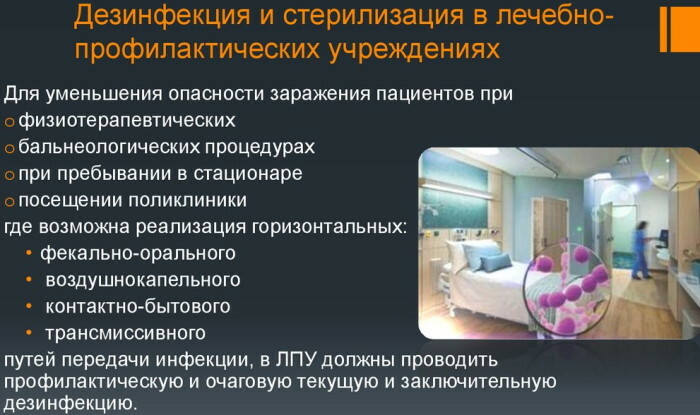
Non-critical objects are subject to disinfection - the surfaces of tables, chairs, bathtubs, floors and walls. Also processing of window sills, thresholds, doors is carried out.
The surfaces of devices and apparatus are wiped with a cloth soaked in disinfectant solutions (Chloramine, DP-2, Formalin, Deoxon, Hydrogen peroxide mixed with a detergent).
Air
Air disinfection is carried out using standard means (bleach, spray). However, room irradiation is considered the most effective method.
Methods:
- Ozonation of air. It is used to destroy various bacteria, viruses, fungi and other pathogens sensitive to ozone.
- Air purifiers with photocatalyst. The effectiveness of the cleaners is due to the interaction of ultraviolet radiation with titanium dioxide.
- Closed and open type ultraviolet emitters. Such devices are capable of destroying Koch's bacillus, viruses (including COVID-19), HIV, fungi, spore microorganisms, mold, as well as antibiotic-resistant microorganisms.

Other means installed in medical institutions (air ionizers, quartzization) can also be used.
Linens
Bedding is subject to various types of exposure (disinfection). Laundry is carried out in washing machines in accordance with the established rules (programs) using disinfectant detergents - hydrogen peroxide or active chlorine.
After washing, the accessories must be dried. The process is carried out in drying drums of washing machines. After drying, the accessories are transferred to ironing. Ironing of linen is done on ironing boards, mannequins or drying and ironing machines, depending on the type of textiles. In extreme cases, the laundry must be disposed of by incineration.
Medical devices and instruments
All medical devices and instruments are also subject to decontamination. Accessories must be wiped off or completely immersed in disinfectant solutions. Steel products are boiled or burned. Disinfection in a dry heat cabinet is performed for at least 45 minutes. at a temperature of 120 0C.
Methods and types of disinfection in healthcare facilities, algorithm of carrying out
Disinfection in health care facilities (types and methods of exposure must be approved by the head physician of the institution) are performed regardless of the epidemiological situation in the area, city.
There are several different types and methods of disinfecting accessories and other objects located in the premises.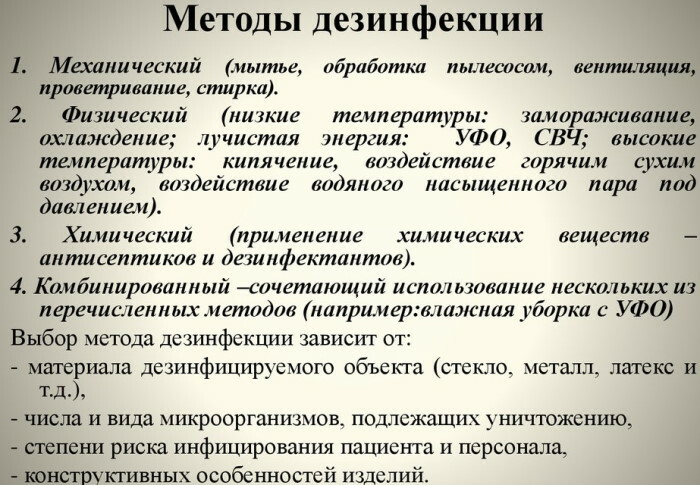
| Methods of exposure | Description |
| Physical | They are subdivided, in turn, into mechanical, thermal and radiant methods. The first type includes manual processing of premises, bed linen. Thermal methods mean means using high temperatures (ironing, boiling, calcining). The third method includes various emitters. |
| Chemical | These methods imply the use of chemical solutions with a wide range of antimicrobial, antibacterial and antiviral activity. By execution, they are divided into the following subspecies: irrigation, spraying, wiping and full immersion in the solution. |
| Biological | For disinfection of objects and accessories, biological filters and biothermal chambers are used. |
| Combined | These methods combine several types of exposure at once. For example, chemical solutions can be used for the treatment of premises, wet cleaning can be carried out, rooms (wards) can be ventilated. |
This or that method is used according to the prevailing epidemiological situation or according to indications.
Preventive
Preventive disinfection is carried out in order to prevent the development and formation of bacteria in the room.
In total, there are 3 forms of disinfection:
- Planned. Performed to prevent the formation of colonies of parasites, rodents. The procedures are carried out in accordance with epidemiological standards and indications. In this case, all surfaces, drinking water, and skin are subject to disinfection.
- For epidemiological indications. The procedure is performed according to the epidemiological situation (specific form of microorganisms). It is performed in rooms where there is no outbreak of the disease.
- According to sanitary and hygienic standards. Disinfection of premises is carried out once, based on the state of objects and accessories.
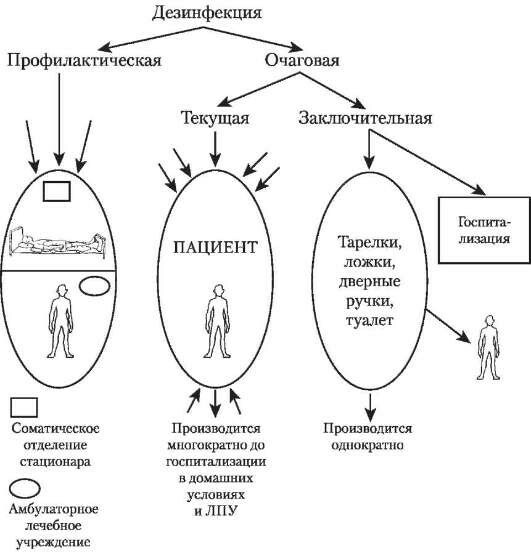
Preventive measures are mandatory for every institution.
Focal
This type of disinfection is carried out in rooms where an outbreak of a disease is detected. The purpose of the procedure is to prevent the spread of infection to other rooms and objects.
Disinfection is carried out in the presence of the patient daily (or according to indications) until the moment of his discharge from the hospital.
All accessories and objects are subject to exposure, including the treatment of linen and hands.
The final
Final disinfection is carried out after the patient is discharged, transferred to another department (ward), or in case of death.
The purpose of the procedure is the complete focal destruction of bacteria after preliminary disinfection of the entire room.
The procedure is performed once, taking into account the pathogenic microflora.
Disinfectants
Disinfectants used for treatment of healthcare facilities must be included in the list of officially approved products by the Ministry of Health. In total, there are about 242 types of various drugs and solutions.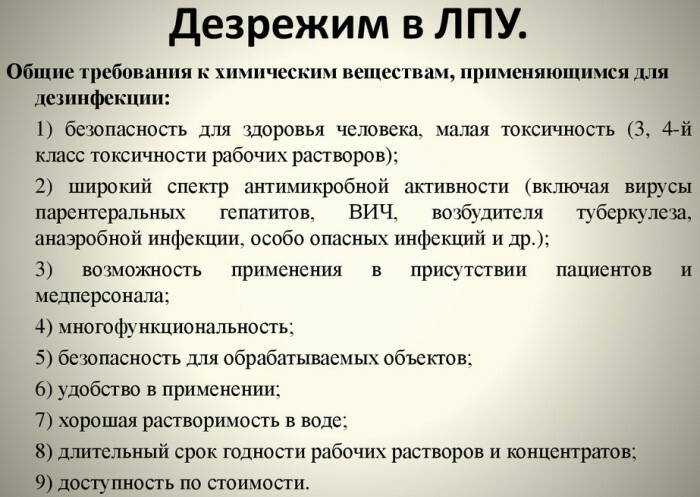
In this case, it is necessary that the tools used meet the following requirements:
- safety for humans;
- high disinfecting effect in the shortest possible time;
- compatibility of procedures (components of preparations) with materials of accessories, objects;
- range of application - for removing organic or inorganic contaminants;
- high and stable result;
- the possibility of using solutions of various concentrations.
Alcohols, halogenated agents, phenolic compounds, amines, guanidines, aldehydes are used as groups of agents.
Disinfection and sterilization
Disinfection and sterilization are carried out on all items that have come into contact with blood, wound surfaces or mucous membranes of the patient.
Processing means:
- Dry heat or hot air. Processing is carried out in special cabinets at temperatures from 160 to 1700WITH. The duration of exposure is 1-1.5 hours. The procedure is applicable for dishes, tools, mineral oils, petroleum jelly.
- Fire treatment. Used for cleaning glass and metal products.
- Boiling. Sterilization is carried out with the addition of sodium carbonate. Processing is suitable for instruments, rubber tubes, needles and syringes.
-
Autoclave. Sterilization is carried out using high pressure steam and is intended for cleaning linen, dressings, rubber accessories.

- Chemical attack. It is used extremely rarely, since the accessories must be additionally cleaned of chemical residues.
- Infrared and ionizing sterilization. Both methods have a high antimicrobial spectrum of action and are used to process disposable medical devices during the manufacturing process.
Among the products, sterilization is often carried out with ozone, formaldehyde or hydrogen peroxide vapor. The name of the drugs is approved by the Ministry of Health.
Disinfection and cleaning
Disinfection in healthcare facilities (the types of treatment differ not only in the methods used, but also in the indications) and cleaning precede the sterilization procedure. It is carried out in order to destroy pathogenic microorganisms and cleanse it from various contaminants.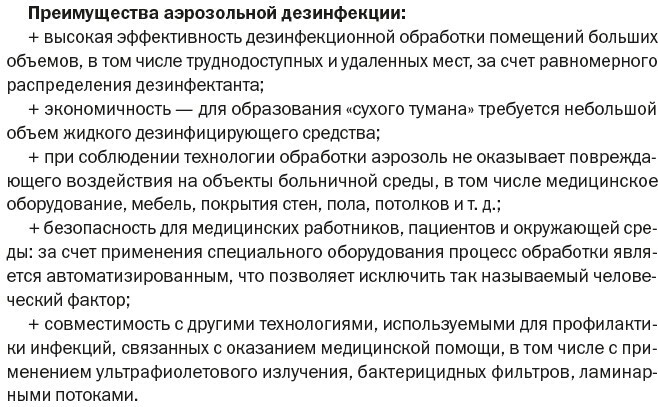
Stages:
- soaking in a washing solution;
- manual washing;
- mechanical restoration;
- rinsing;
- drying.
The cleaning of accessories and other objects is done both chemically and physically.
Disinfection solution
Solutions are used to disinfect surfaces, objects and tools from various bacteria and viruses.
The following groups of tools are used to process objects:
- halogen solutions - Betadine, Chlorhexidine, active chlorine;
- oxidizing agents - potassium permanganate, hydrogen peroxide, perhydrol;
- alcohol and aldehyde-containing agents - ethanol, formaldehyde;
- metal salts - mercuric chloride, sodium chloride;
- phenols - Carbol.
Combined funds can also be used, which include several active ingredients.
All funds must have the necessary quality certificates and comply with the sanitary and epidemiological standards established by the Ministry of Health.
Disinfection tablets
The products are available in dry form in the form of tablets or granules. They are used for disinfection of surfaces, accessories or in water tanks (baths, swimming pools).
The composition and method of using the funds depends on the indications. The tablets can be used in case of outbreaks of an epidemic or as a preventive disinfection.
The most effective and approved by the Ministry of Health means such drugs as Chloritex (various concentrations), Aquatabs, Equitall.
Disinfection of premises and objects located within the medical facility should be carried out regularly in accordance with the established rules and regulations. At the same time, any disinfecting procedures (regardless of the type) should be performed only by specially trained specialists.
Disinfection video
Disinfection - types, methods and methods:

